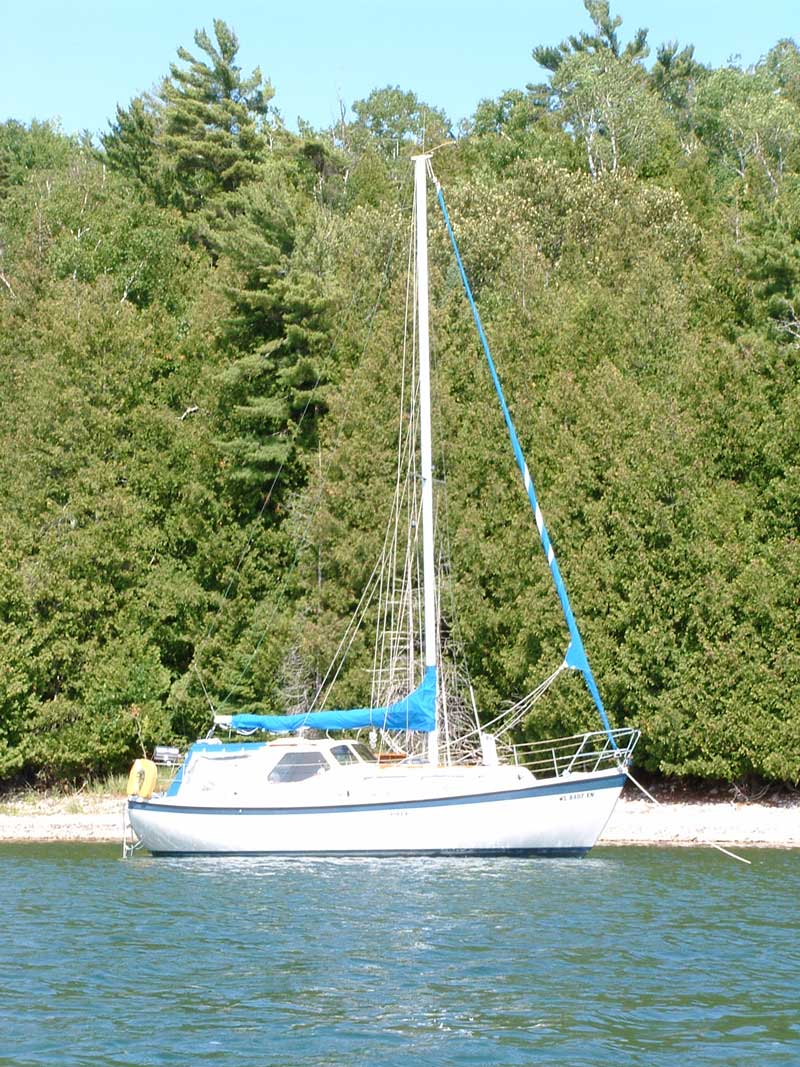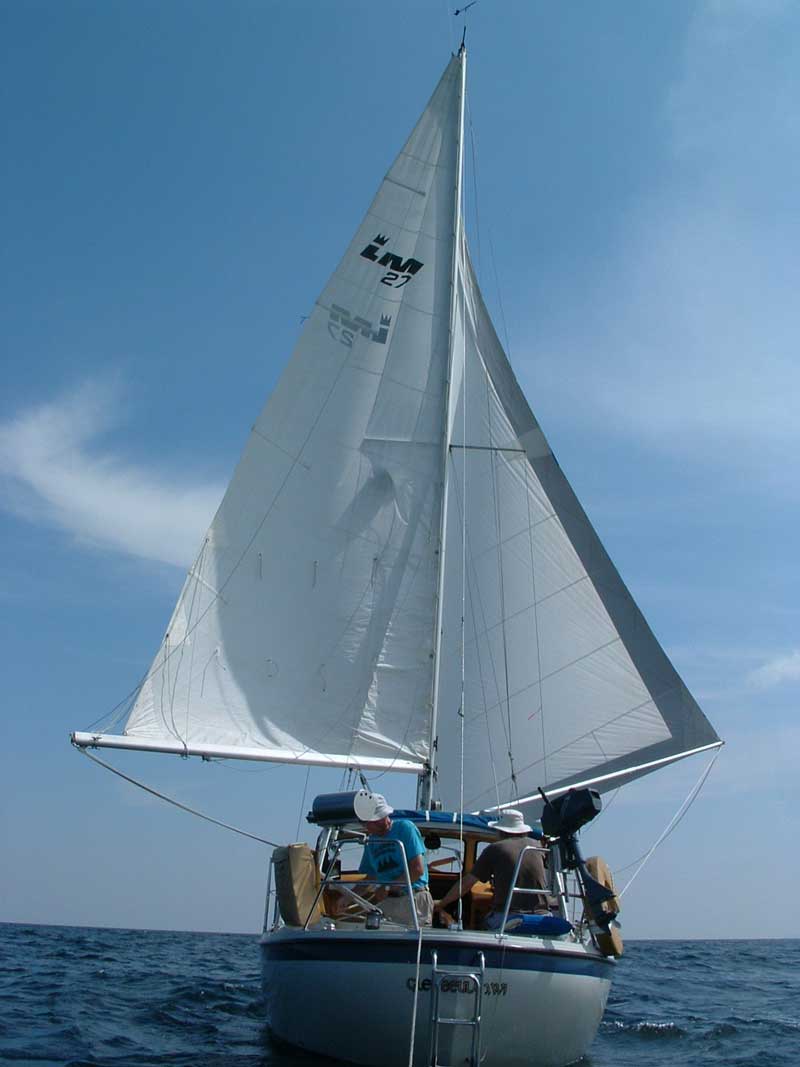Sailing and Snorkling Green Bay and Bay
De Noc
By George Alexander
Two of my brothers and I began our week long adventure on a warm and sunny August Sunday, departing Menominee Michigan where we dock "Piper", a 27 foot LM pilothouse sailboat. With a strong southwesterly breeze, we sailed easily downwind wing on wing toward Washington Island off the tip of the Door County peninsula. Our destination the first day was the anchorage Jackson Harbor, a sleepy fishing village at the north end of the island. We were surprised to view a pair of coyotes on the beach of the island as we sailed by. Before reaching our anchorage we took a detour into Washington Harbor, an open bay also at the top of the island which was the location or our first snorkeling adventure. Located inside the bay along the east shore are the remains of the 267 foot steamer, Louisiana, a bulk cargo carrier wrecked in one of the worst storms in Lake Michigan history. Built in 1887, the Louisiana was bound toward Escanaba Michigan on November 8, 1913 when she encountered a fierce storm while negotiating Death's Door Passage at night. Seventy mile an hour winds filled the passage with huge crashing breakers. The captain sought refuge in Washington Harbor, but the Louisiana's anchors could not hold in the fierce conditions and she was driven aground. While the crew tried to wait out the storm for rescue in calmer conditions, a fire broke out in the cargo hold which grew out of control and forced the crew to abandon the stranded ship. In addition to the loss of the Louisiana, 19 other vessels were wrecked with a loss of 248 seamen during the "Big Blow of 1913". Today the broken bow section lies on shore near the submerged hull remnants, which are under 2 to 12 feet of water. The remaining hull section has interesting features visible such as the centerboard trunk, bilge pump housing and engine mount.
 |
| Piper at anchor. |
The next morning we were greeted with a sunny day and a flock of Mute Swans
with chicks swimming in the harbor. Northerly winds prompted us to return
south to the main protected bay of Washington Island, Peterson Bay at the
other end of the Island. The bay is actually a large area protected from the
lake side by an island and extensive shallows with several anchorages
available for those who do not wish to stay at one of the two marinas
located there. We anchored in a protected bay on the north side, where it
was an easy dingy ride to shore for a walk on the island's paved roads and a
stop at custard stand for a snack.
With light winds on Tuesday, we again headed north toward Summer Island, the
location for two more snorkeling opportunities. Our first destination was a
charted wreck on the Lake Michigan side of the island shown to be in shallow
water. Previous experience with noted wreck sites has not always resulted in
findings, so we were not sure if we would find any remnants. Fortunately,
the light winds and calm and clear water made it easy to see bottom 10 to 12
feet deep, and we were able to locate the hull exactly where charted about
50 yards off the beach in 5 to 10 feet of water. The C. C. Hand, another
bulk freighter, was built in 1890 and stranded off Summer Island on October
7, 1913. While stranded, she caught fire and burned to a total loss.
 |
| View from dinghy behind stern wing on wing. |
This hull had several interesting features including an apparent propeller
shaft bearing mount with mating parts scattered nearby. We had seen
published reports that the propeller would be found with the hull, but it
was missing, apparently salvaged at an earlier time. Also very evident was
the steel cross bracing used to reinforce & stiffen the hull. This was a
"second generation" lake freighter innovation which created cargo holds
without internal bracing and an open cargo area from stem to stern. On shore
there also appeared to be some boiler parts.
The C.C. Hand wreck site was located about a mile from our destination for
the night, Summer Harbor, a cove open to the north/north east with a
generally rocky bottom and small sandy area for setting an anchor. With
light southerly winds and no storms forecast for overnight, we elected to
anchor for the night. At the entrance to the bay there are two hulls which
were partially loaded with limestone and sunk in 1925 to form a breakwater
for a quarry. One of these vessels was the Nyack, a passenger & freight
steamer which had burned in 1915 and had been converted to a barge before
being scuttled. Notable at this location is the steel rudder post for one of
the hulls. Due to low lake water levels, it projects several feet above the
water's surface. This hull also has two large rectangular structures which
appeared to be tanks of some sort and the bow which has been sheared off and
lying nearby.
Due to favorable winds, we were able to sail again the next day. We headed
for a favorite anchorage on the Garden Peninsula of Michigan, South River
Bay, located on the eastern side of Big Bay De Noc . This is a well
protected anchorage which has abundant wildlife such as Bald Eagles, Osprey,
Canadian Geese, Sand Hill Cranes, and Turkey Vultures. There were no wrecks
here but trails are available for walking, and the small community of Garden
is about 3 miles by road where we found small grocery store and
tavern/restaurant. Also nearby is Fayette, a state park with a wonderful
snail shell harbor, available dockage, and a partially restored iron ore
smelting village to tour.
Dwindling ice and holding tank capacity necessitated a trip to a marina and
we chose Escanaba Michigan on Little Ban De Noc as our next destination.
There we found a well kept state run marina with good restaurants a short
walk up the street. There also is a historical museum in the old lighthouse
with lots of information on early marine history of the area. Here we
discovered another wreck we could explore. The Nahaut, a 213 foot ore
carrier launched in 1873 was loading iron ore at dock #4 on November 29,
1987 when she caught fire and burned to the waterline. So intense and fast
spreading was the fire that two crewmen were unable to escape and lost their
lives. Additionally, the dock caught fire and was completely destroyed as
well. The hull was towed into the bay and sunk near shore north of the
historical museum. It is located very near a navigational marker several
hundred yards off shore in shallow water of about 5 feet to 12 feet, and is
easy to locate.
 |
The next day we motored in a headwind down the bay and on to Rock Island, a
Wisconsin state park at the end of the Door County peninsula, just across
the water from Jackson Harbor where we had anchored earlier in the week.
Located at the park is a wonderful three story tall boathouse with a large
hall above built by Chicago businessman Chester Thordarson in the early
1900's. This building was constructed of local limestone and was the start
of an ambitious plan to build a retreat for employees and friends which
unfortunately ended due to the depression. Inside the hall is a massive
fireplace, displays of local history and ecology and original carved wooden
tables and chairs designed specifically for the hall. Also available on the
island is a tour of the restored lighthouse (the first Federal lighthouse on
Lake Michigan) given by volunteers who spend a week at the lighthouse in
return for guiding tours. Dock space is limited at Rock Island, so we chose
to return to Jackson Harbor for the night. During the afternoon we walked in
a local natural area protected by the Nature Conservancy which has unique
landforms as well as quite a bit of the endangered plant species, Dwarf
Beach Iris.
With our week at an end, we reluctantly returned to Menominee completing our
sailing & snorkeling tour of Green Bay, Big and Little Bay De Noc bidding
goodbye to each other and looking forward to another trip soon!
George Alexander is a freelance writer from Glenbeulah, WI. He has sailed
his 27’ LM Motorsailer for about 10 years, chartered prior to that, and has
sailed since age 12 in small boats.
All contents are copyright (c) 2007 by
Northern Breezes, Inc. All information contained within is deemed reliable
but carries no guarantees. Reproduction of any part or whole of this
publication in any form by mechanical or electronic means, including
information retrieval is prohibited except by consent of the publisher.